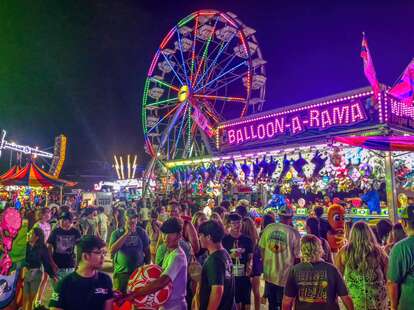The Midwest’s State Fairs Are so Much More Than Butter Sculptures
The region takes the blue ribbon for these time-honored celebrations.
Put everything people love to judge about the Midwest under a tent: ill-fitting Big 10 T-shirts, palaces made out of corn, the stench from the 7:1 pig-to-human ratio. Throw in some Nickelback blasting over the Tilt-A-Whirl and nauseated teens testing their luck on the Zipper. Bring along your prize horses and your butter wagon, deep fry it all in batter, and garnish with blue ribbons. Voila: You've got yourself a Midwestern state fair.
As a kid growing up in Iowa, the annual state fair felt designed to celebrate, laud, and even award everything I was told to hate about being Midwestern. To me, they were pop-up churches to grease, whiteness, conservatism, and big agriculture. Men competed to lasso bulls and carve the biggest butter cow. Women competed to see who could shout loudest for their husbands and bake the perfect blueberry pie. Politicians competed to look the most natural while holding foods on sticks. The fairs were little more than week-long August devotions to keeping rural, 20th-century culture alive.
I wanted none of it.
You wouldn’t catch me at a state fair growing up —I beelined from the parking lot to the mini-donuts and back with the quickness of a deep-fried grilled cheese slipping through your grease-covered hands. As the years passed, not much seemed to change, and I made up my mind that I would always be right about these mass gatherings of excess.
And then, while I wasn’t paying attention, the Midwest’s state fairs transformed. They suddenly became the nation’s greatest food and music festivals. Out of nowhere, rapper Ludacris seemingly rolled out to become a fixture on every state-fair grandstand. Now I stand—partially, mostly, sort of—corrected.
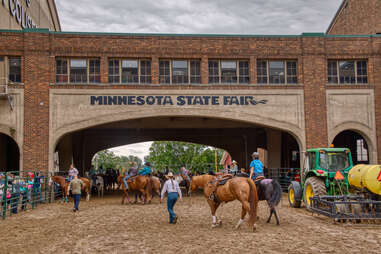
If the world is a food blog with flashing ads you can’t close, state fairs are that red-and-white Better Homes & Gardens cookbook stashed on your mom’s kitchen shelf. If the world is Gwyneth Paltrow’s bone broth and million-dollar starter homes, state fairs are a fresh-baked pie from your next-door neighbor. And if the world is writers’ strikes and climate doom and three indictments, state fairs are MTV playing music videos and Barack Obama’s tan suit.
Midwestern state fairs do these “simpler times'' exceedingly well. At the Wisconsin State Fair, for example, you can kick it in the milking parlor (it’s exactly what it sounds like) while devouring the “Original Cream Puff.” At the Iowa State Fair, you can make a 2-mile hike out of strolling the Avenue of Breeds, the Swine Barn, and the Livestock Pavilion. At the South Dakota State Fair, you can turn off the 21st century at one of multiple rodeos, the car and tractor shows, and—of all things—the grocery-bagging competition.
Sure, this time-capsule appeal can be found in state fairs all across the US—and here is where you probably expect me to say that nowhere does vegetable oil and fashion faux pas better than the Midwest. But that’s the thing: It’s not exactly true. Every state fair has a time-capsule appeal because every state fair holds onto its 1950s politics and unnecessary gun holsters, its fried cheese and tucked-in T-shirts, its quilting competitions and horse shows.
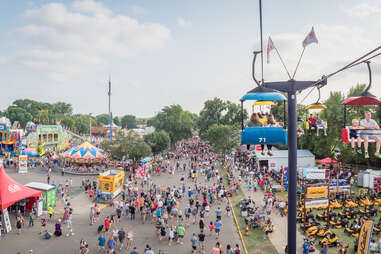
But if Midwestern state fairs do have anything in common, it’s that they celebrate themselves louder than anyone else—and that’s saying something. While California, New York, and Texas have incredibly popular fairs, per capita the Midwest blows everywhere out of the water. The Minnesota State Fair regularly sees 2 million attendees (the population of the entire state is 5.7 million); Iowa gets more than 1 million visitors—just over one-third of its population; so too does Wisconsin.
Now, it’s possible those millions come knocking to experience the old-school, god-fearing goodness of pastel roller coasters and hog-tying and 3,000-calorie snacks. Maybe, like me, the masses are growing sick of screens, social-media influencers, and 30% tips out in the “real” world. Maybe they just want to carb-load in the peace and quiet of a chili cook-off.
Or, against all odds, these annual celebrations have evolved to offer a little of everything to everyone who wants to unplug and indulge in some traditional Americana. And, dare I say, an elevated version of it.
Here’s what broke my kid brain: Midwestern state fairs are a little bit hip now.
(Cue the Ludacris.)
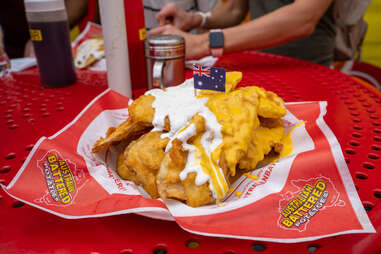
When it comes to live entertainment, the Midwest’s state fairs have done a complete about-face—no more are they the realms of Kenny Rogers, Alabama, the Beach Boys. Just look at the 2023 Illinois State Fair lineup, with Nelly, Ashanti, Ja Rule, and Alanis Morrisette. Or Iowa’s, with The Black Keys and Ludacris. North Dakota features T-Pain and… Ludacris. And in Wisconsin, they’ve got an all-star lineup of Edwin McCain, Salt-N-Pepa, and—yup—yet more Ludacris.
Attracting hundreds of thousands of visitors (including one very enthusiastic Chris Bridges), they’re becoming spectacular tributes to the Millennials and Gen Xers who once shunned the very concept of the state fair, offering us 10-plus days of genre-hopping entertainment from our college years. Turn off your phone and it could be 2006 again, but this time you don’t care if your crush notices you and you’ve got money to burn on non-alcoholic mules, Middle Eastern tacos, beef arepas, and chicken momo.
Wait, what? Right. The food has had its own global revolution, too: At this year’s Wisconsin State Fair, the non-alcoholic Ferris Mule won the annual “Sporkies & Drinkies” competition, a mix of ginger beer, fresh blackberries, lime juice, and agave nectar topped with a rosemary sprig and a slice of lime. Wisconsin’s food vendors range from those classic dill-pickle cheese curds and funnel cakes to international finds like bug chow mein (actual bugs!), shrimp etouffee, and Filipino pizza lumpia. The same thing can be said for Minnesota—momo and Hmong-style galabao, sambusas, and Amish donuts (and, naturally, lutefisk steam buns). Once beacons for the young and hip to ironically consume fried butter, the Midwest’s fairs have become annual darlings of food journalists, travel publications, cable shows, and more.
(Of course, you can still get fried butter and mini donuts. Some things, after all, are sacred.)
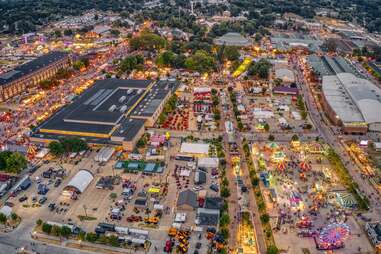
And then there’s the art—whatever form it takes. Because at these fairs, artisans are everywhere. The Michigan State Fair runs a brewing competition; Wisconsin crowns bonsai champions and artists draw the scene at Plein Air at the Fair; Indiana puts basketball on every medium it can find, from paper and mural to screen and hoop. Iowa’s classic butter cows may still be memorialized, but now they’re also carving the likes of Caitlin Clark and Kurt Warner.
But even the quilting contests and chili cook-offs, which largely remain the same as they ever were. have taken on a new glow in this digital age: They’re made and won and realized by real people. From husband-hollerers to bull-lassoers to caricaturists, they’re real people with real skill, doing a thing most of us could never do in front of our very eyes. You can watch them in real life, practicing their art in front of thousands. (Some of whom are judgy, insecure teenagers struggling with being Midwestern like I was.) They’re the opposite of AI, of corporate-sponsored programming, of red-hat politicians faking their way across the same 4H stage. They’re real people honing family tradition, and they’re damn good at what they do.
I couldn’t appreciate that before—all I could see were the truck nuts, the grifters, the backwards politics. Those are definitely still there, but they’re also everywhere. Far outnumbering all that are the humans baking pies, showing off their horses, and perfecting their BBQ sauces for all to enjoy. That’s a ratio worth celebrating.
Maybe it’s even worth a blue ribbon.
